2010 AUDI S6 ignition
[x] Cancel search: ignitionPage 227 of 368
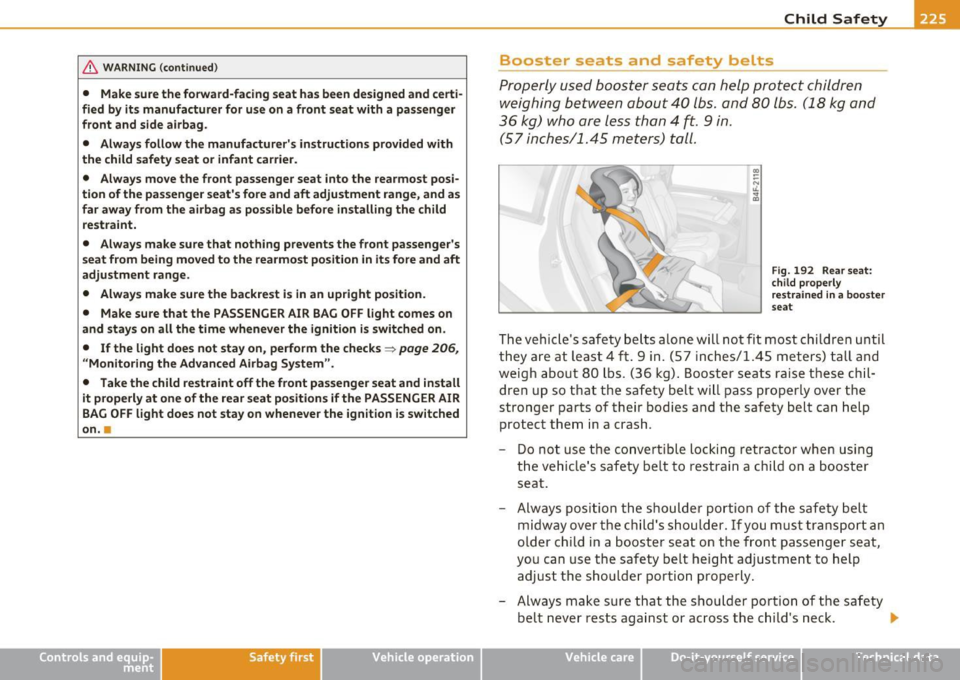
& WARNING (continued)
• Make sure the forward-facing seat has been designed and certi·
fied by its manufacturer for use
on a front seat with a passenger
front and side airbag.
• Always follow the manufacturer's instructions provided with
the child safety seat or infant carrier.
• Always move the front passenger seat into the rearmost posi
tion of the passenger seat's fore and aft adjustment range, and as
far away from the airbag as possible before installing the child
restraint.
• Always make sure that nothing prevents the front passenger's
seat from being moved to the rearmost position in its fore and aft
adjustment range.
• Always make sure the backrest is in an
upright position.
• Make sure that the PASSENGER AIR BAG
OFF light comes on
and stays on all the time whenever the ignition is switched
on.
• If the light does not stay on, perform the checks => page 206,
"Monitoring the Advanced Airbag System".
• Take the child restraint off the front passenger seat and install
it properly at one of the rear seat positions if the PASSENGER AIR
BAG
OFF light does not stay on whenever the ignition is switched
on. a
Safety first Vehicle OP-eration
Child Safety
Booster seats and safety belts
Properly used booster seats can help protect children
weighing between about 40 lbs. and 80 lbs. (18 kg and
36 kg) who are less than 4 ft.
9 in.
(57 inches/1.45 meters) tall .
Fig. 192 Rear seat:
child properly
restrained in a booster
seat
The vehicle's safety belts alone will not fit most children until
they are at least 4 ft. 9 in. (57 inches/1.45 meters) tall and
weigh about 80 lbs. (36 kg). Booster seats raise these chil
dren up so that the safety belt will pass properly over the
stronger parts of their bodies and the safety belt can help
protect them in a crash.
- Do not use the convertible locking retractor when using
the vehicle's safety belt to restrain a child on a booster
seat.
- Always position the shoulder portion of the safety belt
midway over the child's shoulder. If you must transport an
older child in a booster seat on the front passenger seat,
you can use the safety belt height adjustment to help
adjust the shoulder portion properly.
- Always make sure that the shoulder portion of the safety
belt never rests against or across the child's neck.
9'>
Vehicle care Do-it-yourselt service iTechnical data
Page 229 of 368
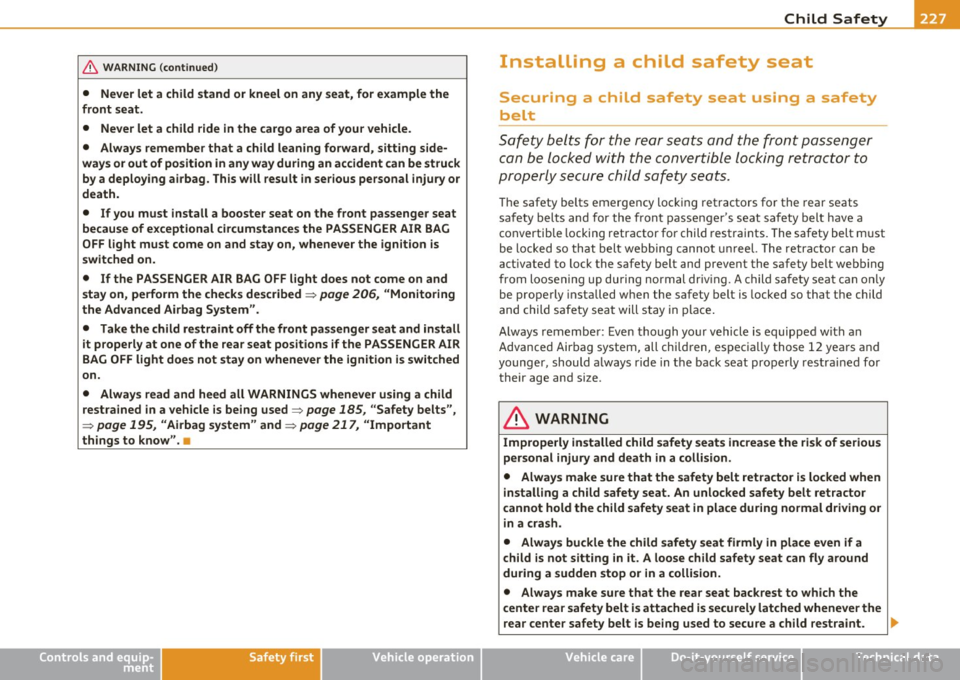
_____________________________________________ C _h_i_ld _ S_ a_ f_ e_ t__. y'---_l!ft'II
& WA RNING (c on tinued )
• Never let a child stand or kneel on an y seat , for e xample the
front seat.
• Never let a child ride in the cargo area of your vehicle .
• Always remember that a child leaning forward , sitting s ide
ways or out of position in any way during an accident can be struck
by a deploying airbag . This will result in se rious personal injury or
death.
• If you must install a booster seat on the front passenger seat
because of exceptional circumstance s the PASSENGER AIR BAG
OFF light must come on and stay on , whenever the ign ition is
switched on.
• If the PASSENGER AIR BAG OFF l ight does not come on and
s tay on , perform the checks described =>
page 206, "Monitoring
the Advanced Airbag System ".
• Take the child re straint off the front pa ssenger seat and in stall
it properly at one o f the rea r seat positions if the PASSENGER AIR
BAG OFF light does not stay on whenever the ignition i s swit ched
on.
• Alway s read and heed all WARNINGS whenever u sing a child
restrained in a vehicle is being used =>
page 185, "Safety belts",
=>
page 195 , "Airbag sy stem " and => page 217, "Important
things to know ".•
Controls and equip ment Safety first Vehicle operation
lnstalli ng a child safety seat
Securing a child safety seat using a safety
belt
S
afety belts for the rear sea ts and the fron t passen ger
can be l ocke d with th e co nverti ble lo cki ng retract or to
p ro p erly secur e child saf ety seats.
T he safety belts emergency locking retractors for the rear seats
safety belts and for the front passenge r's se at safety belt have a
convertible locking retractor for child restrai nts. The safety belt must
be locked so that belt webbing canno t unreel. The retra ctor can be
act ivated to lock the safety belt and prevent the safety belt webb ing
fr om loosen ing up du ring normal dr iv ing. A child sa fe ty sea t can on ly
be properly installed when the safety belt is locked so that the child
and child safety sea t will s tay in place .
Always remembe r: Even tho ugh yo ur vehicle is equipped w ith a n
Advanced Airbag system, all ch ildren, espec ia lly those 12 yea rs and
younge r, should a lways ride in t he back seat properly res tra ined for
their age and size.
& WARNING
Improperly in stalled child safety seats increase the risk of serious
personal injury and death in a collision .
• Always make sure that the safety belt retractor is locked when
installing a chi ld safety seat . An unlocked safety belt retractor
cannot hold the child safety seat in place during normal driving or
in a crash .
• Always buckle the child safet y seat firmly in place even if a
child is not sitting in it. A loose child safety seat can fly around
during a sudden stop or in a colli sion.
• Always make sure that the rear seat backrest to which the
center rear safety belt is attached is securely latched whenever the
rear center safety belt is being used to secure a child restraint.
9JI,
Vehicle care Do-it-yourself service Technical data
Page 230 of 368
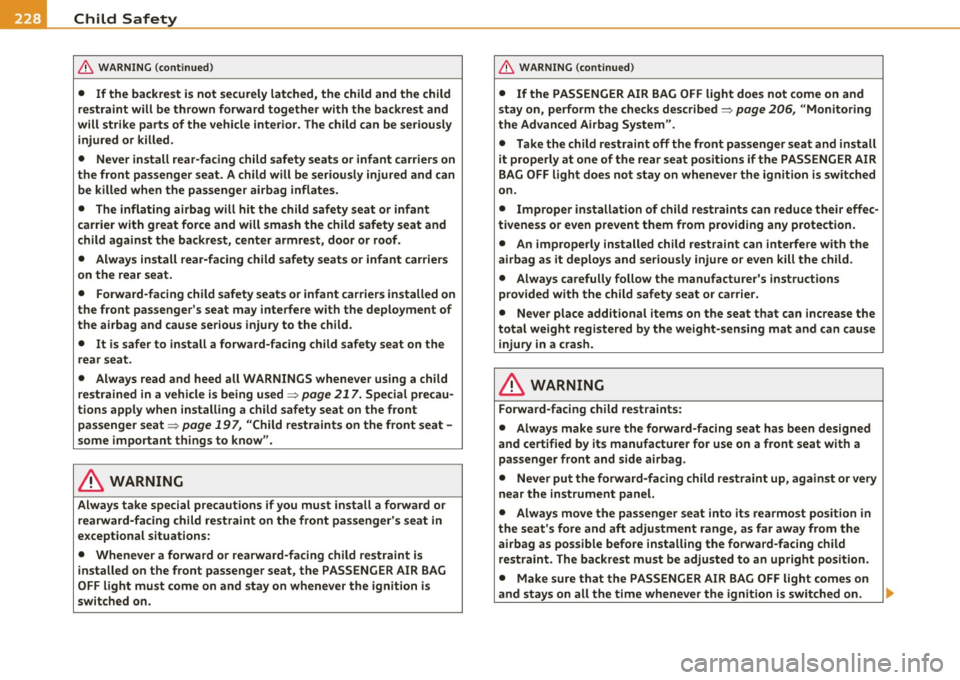
.,.___C_ h_ il_d _ S_a _ f_ e _ t--= y '------------------------------------------------
& WARNING (cont inued)
• If the backrest is not securely latched, the child and the child
restraint will be thrown forward together with the backrest and
will strike parts of the vehicle interior. The child can be seriously
injured or killed.
• Never install rear-facing child safety seats or infant carriers on
the front passenger seat. A child will be seriously injured and can be killed when the passenger airbag inflates.
• The inflating airbag will hit the child safety seat or infant
carrier with great force and will smash the child safety seat and
child against the backrest, center armrest, door or roof .
• Always install rear-facing child safety seats or infant carriers
on the rear seat.
• Forward-facing child safety seats or infant carriers installed on
the front passenger's seat may interfere with the deployment of
the airbag and cause serious injury to the child.
• It is safer to install a forward -facing child safety seat on the
rear seat.
• Always read and heed all WARNINGS whenever using a child
restrained in a vehicle is being used~
page 217. Special precau
tions apply when installing a child safety seat on the front
passenger seat~
page 197, "Child restraints on the front seat -
some important things to know".
L1}. WARNING
Always take special precautions if you must install a forward or
rearward -facing child restraint on the front passenger's seat in
exceptional situations:
• Whenever a forward or rearward-facing child restraint is
installed on the front passenger seat, the PASSENGER AIR BAG
OFF light must come on and stay on whenever the ignition is
switched on.
& WARNING (co ntinued )
• If the PASSENGER AIR BAG OFF light does not come on and
stay on, perform the checks described
~ page 206, "Monitoring
the Advanced Airbag System".
• Take the child restraint off the front passenger seat and install
it properly at one of the rear seat positions if the PASSENGER AIR
BAG OFF light does not stay on whenever the ignition is switched
on.
• Improper installation of child restraints can reduce their effec
tiveness or even prevent them from providing any protection.
• An improperly installed child restraint can interfere with the
airbag as it deploys and seriously injure or even kill the child.
• Always carefully follow the manufacturer's instructions
provided with the child safety seat or carrier.
• Never place additional items on the seat that can increase the
total weight registered by the weight-sensing mat and can cause injury in a crash.
L1}. WARNING
Forward-facing child restraints:
• Always make sure the forward-facing seat has been designed
and certified by its manufacturer for use on a front seat with a
passenger front and side airbag .
• Never put the forward-facing child restraint up, against or very
near the instrument panel.
• Always move the passenger seat into its rearmost position in
the seat's fore and aft adjustment range, as far away from the airbag as possible before installing the forward-facing child
restraint . The backrest must be adjusted to an upright position.
• Make sure that the PASSENGER AIR BAG OFF light comes on
and stays on all the time whenever the ignition is switched on . _.
Page 231 of 368
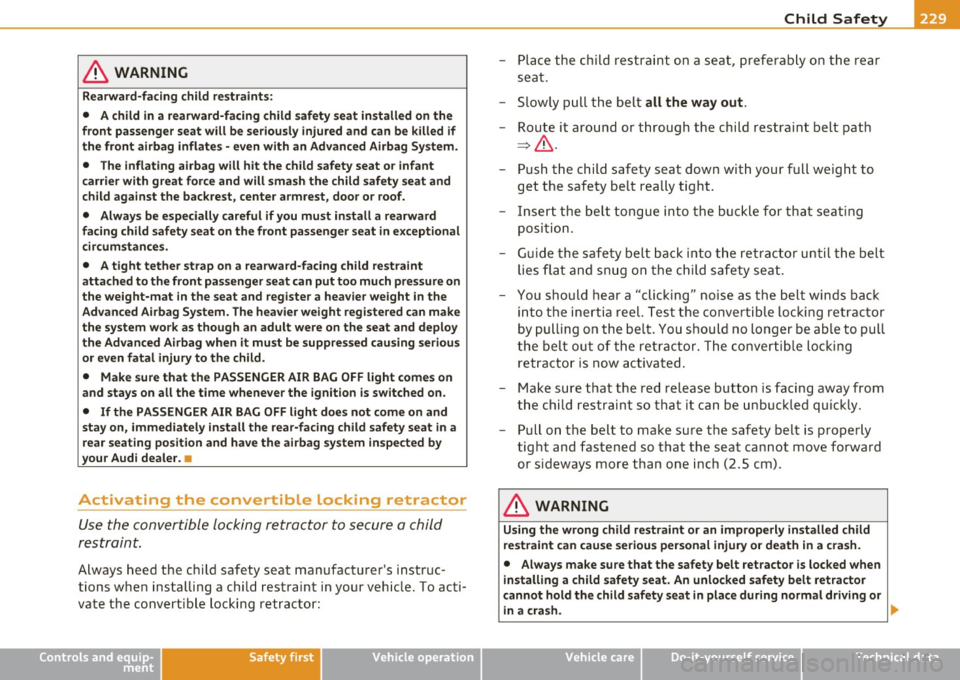
_____________________________________________ C _h_i_ld _ S_ a_ f_ e_ t ... Y'--- __
& WARNING
Rearward-facing child restraints:
• A child in a rearward-facing child safety seat installed on the
front passenger seat will be seriously injured and can be killed if
the front airbag inflates -even with an Advanced Airbag System.
• The inflating airbag will hit the child safety seat or infant
carrier with great force and will smash the child safety seat and
child against the backrest, center armrest, door or roof.
• Always be especially careful if you must install a rearward
facing child safety seat on the front passenger seat in exceptional
circumstances.
• A tight tether strap on a rearward-facing child restraint
attached to the front passenger seat can put too much pressure on
the weight-mat in the seat and register a heavier weight in the
Advanced Airbag System. The heavier weight registered can make
the system work as though an adult were on the seat and deploy
the Advanced Airbag when it must be suppressed causing serious
or even fatal injury to the child.
• Make sure that the PASSENGER AIR BAG OFF light comes on
and stays on all the time whenever the ignition is switched on.
• If the PASSENGER AIR BAG OFF light does not come on and
stay on, immediately install the rear-facing child safety seat in a
rear seating position and have the airbag system inspected by
your Audi dealer. •
Activating the convertible Locking retractor
Use the convertible locking retractor to secure a child
restraint.
Always heed the child safety seat manufacturer's instruc
tions when installing a child restraint in your vehicle. To acti
vate the convertible locking retractor:
Controls and equip
ment Safety first Vehicle operation
-
Place the child restraint on a seat, preferably on the rear
seat.
- Slowly pull the belt
all the way out.
- Route it around or through the child restraint belt path
=>& .
- Push the child safety seat down with your full weight to
get the safety belt really tight.
- Insert the belt tongue into the buckle for that seating
position.
- Guide the safety belt back into the retractor until the belt
lies flat and snug on the child safety seat.
- You should hear a "clicking" noise as the belt winds back
i nto the inertia reel. Test the convertible locking retractor
by pulling on the belt. You should no longer be able to pull
the belt out of the retractor. The convertible locking
retractor is now activated.
- Make sure that the red release button is facing away from
the child restraint so that it can be unbuckled quickly.
- Pull on the belt to make sure the safety belt is properly
tight and fastened so that the seat cannot
move forward
or sideways more than one inch (2.S cm).
& WARNING
Using the wrong child restraint or an improperly installed child
restraint can cause serious personal injury or death in a crash.
• Always make sure that the safety belt retractor is locked when
installing a child safety seat. An unlocked safety belt retractor
cannot hold the child safety seat in place during normal driving or
in a crash. ._
Vehicle care Do-it-yourself service Technical data
Page 249 of 368
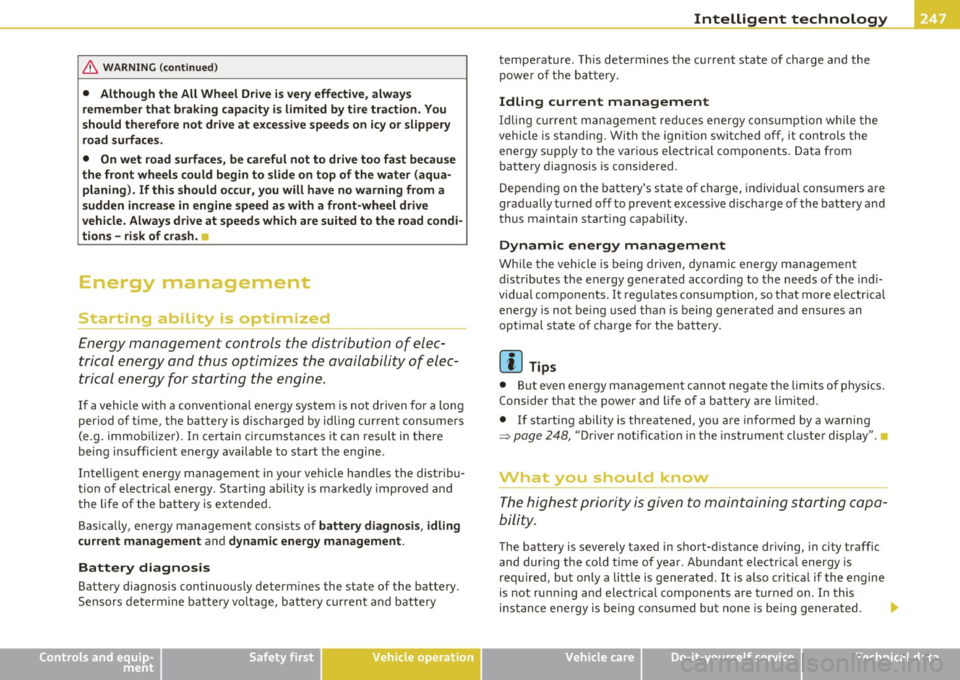
_________________________________________ I_ n_ t _;_e _;__;_ ll;....,igent technology ..__==--
& WA RNING (c on tinued )
• Although the All Wheel Drive is ve ry effe ctive , alway s
remember that braking capacity i s limited by tire traction. You
should the refore not drive at e xce ssive speeds on icy or slippery
road surfaces.
• On wet road surfaces, be careful not to drive too fast because
the front wheel s could begin to slide on top of the water (aqua
planing ). If this should occur, you will have no warning from a
sudden in crease in engine speed as with a front-wheel drive
veh icle. Always drive at speeds which are suited to the road condi
tions - risk of crash. •
Energy management
Starting ability is optimized
f nergy management controls the distri bution of elec
trical energy and thus optimiz es th e availability of elec
tri cal energy for startin g the engine.
If a vehicle with a conventiona l e ne rgy sys tem is not driven fo r a long
period of time, the battery is d ischarged by idling cur rent consumers
(e.g . immo bilizer). In ce rt ain circumstance s it can re sul t in t here
being insufficient energy ava ilab le to start the engine .
Inte lligent energy management in your ve hicl e han dles the dist ribu
t ion of e lectr ica l energy . Starting ability is ma rkedly improved a nd
the life of the battery is extende d.
B as ica lly, energy man agemen t consis ts of
battery diagno sis, idling
current management
and dynamic energy management .
Battery diagnosis
Battery diagnosis continuous ly dete rmines the state of the battery.
Se nso rs de ter mine batte ry vo ltage, ba ttery c urren t and bat tery
Controls and equip
ment Safety first Vehicle operation
temperature
. Th is determines the cur rent state of charge and the
powe r of the b attery.
Idling current management
Idli ng cur rent m anagement reduces energy consump tion w hile the
vehicle is standing. With the ignition switc hed off, it controls the
energy su pply to the v ario us ele ct ric al com po nents. D ata from
battery diagnosis is considered .
Depen ding on the battery's state of charge, individual consumers a re
gradually tu rned off to p revent excess ive d ischa rge of the battery and
thus ma intain start ing capab ility.
Dynamic energy management
Whi le the vehicle is being dr iven, dynamic energy management
dis tributes the energy ge ne rated according to the needs of t he indi
vidua l compo nents.
It regulates consumpt ion, so that more e lectr ica l
energy is not be ing use d tha n is being gene rated and ensures an
optimal state o f charge for the battery.
[I) Tips
• But even energy management cannot negate the limits o f phys ics.
Conside r th at th e p ower and li fe o f a batte ry ar e limi ted.
• If starting ab ility is threatened, yo u are in formed by a warning
=> p age 2 48, "Dr iver n otifi cat ion in the inst rum ent cl uste r displ ay".
What you should know
The high est priority is given to main taining star tin g cap a
bility.
Th e battery is seve rely taxed in sho rt-distanc e dr iving, in city t raffic
and dur ing t he cold time of year. Ab undant e lectr ica l energy is
re qui red, bu t on ly a little is generate d. It is a lso c rit ica l if the engine
is not run ning and electrica l compone nts are turned on. In this
in st an ce e nergy i s being consumed bu t none is being ge ne rat ed. •
Vehicle care Do-it-yourself service Technical data
Page 250 of 368

Intelligent technology
'-------------------------------------------------
It is in precisely these situations that you will notice energy manage
ment actively regulating the distribution of energy.
Vehicle stands for an extended period
If you do not drive your vehicle over a period of several days or weeks,
electrical components are gradually cut back or switched off. This
red uces energy consumption and maintains starting capability over a
longer period.
Take into consideration that when you unlock your vehicle, some
convenience functions, such as the remote key or power seat adjust
ment, may not be avai lab le. The convenience functions wi ll be ava il
able again when you turn on the ignition and start the engine.
With the engine turned off
If you listen to the radio, for example, with the engine turned off o r
use other MMI functions, the battery is being discharged.
If starting capability is jeopard ized due to energy consumption, the
following warning appears in the MMI display:
Please start engine, otherwise system will switch off in
3 minutes .
The warning indicates that the system will be turned off automati
cally after 3 minutes. If you wis h to continue using the funct ions, you
have to start the engine.
With the engine running
Although electrica l energy is generated when the vehicle is being
dr iven, the battery can become discharged. This happens mostly
when little energy is being generated and a great deal consumed and
the battery's state of charge is not optimal.
To bring the energy balance back into equilibrium, consumers which
req uire especially large amounts of energy are temporarily cut back
or switched off . H eating systems in particular require a great deal of
energy. If you notice, for example, that the heated seats* or the
heated rear window are not heating, they have been temporarily cut
back or switched off. These systems will be ava ilable again as soon as
the energy ba lance has been restored. You will also
notice that engine idle speed has been increased
slightly. This is normal and not a cause for concern. By increasing
engine idle speed the addit ional energy required is generated and the
battery is charged. •
Driver notification in the instrument
cluster display
If battery powe r drops into the range where it can limit the ability of
the engine to start, this is shown in the instrument cluster display
w ith the following driver message:
1 Low battery charge: battery will be charged while driving
This notification reminds you that the starting capability of the
eng ine may be limited. As soon as you start driving again, the battery
will be recharged and the notification will go out.
Driver notification appears and goes out again
If this driver notification appears after the ignition is turned on or
wh ile driving and it goes out again after a while, the battery has been
adequately recharged.
Driver notification appears and does not go out
again
If this dr iver not ificat ion appears after the ign it ion is turned on or
whi le driving and does not go out again, the battery's state of charge
is not in the optimal range. Starting ability is restricted . Have the
battery checked as soon as possible at a dealership.
Page 253 of 368
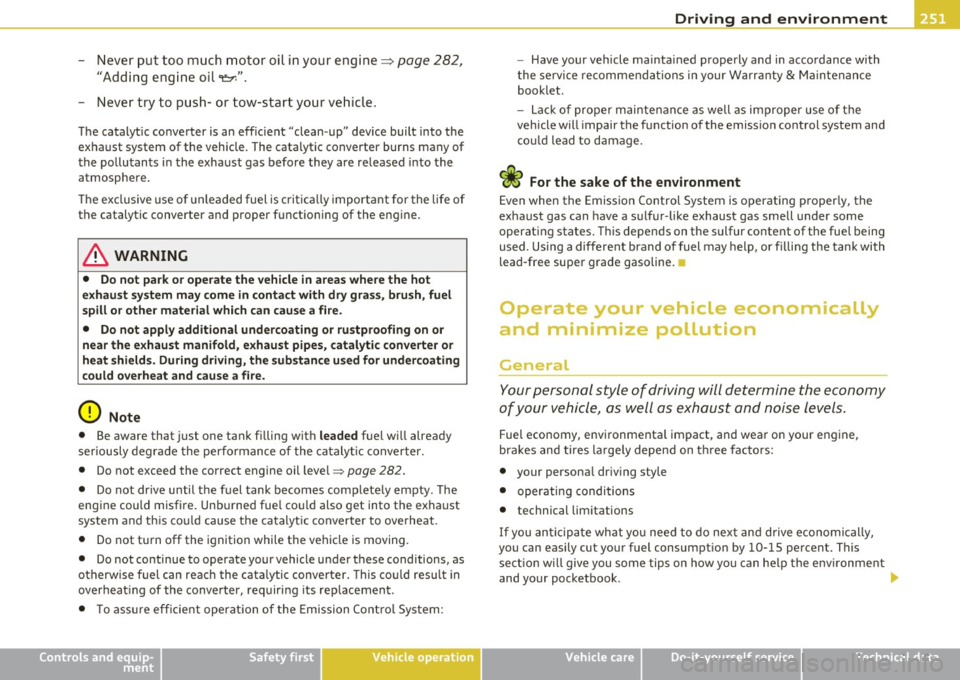
Driving and environment
------------------------------------------------'
-Nev er p ut too much motor oil in yo ur eng ine=:> pag e 282 ,
"A dd ing eng ine o il 't=:r.".
- N ever try to push- or tow-star t your ve hicle.
Th e catalyt ic conve rter is an eff ic ient "clean-up" device built into the
ex ha ust system of the vehicle . The catalytic converter burns many of
t he pollu tan ts i n the exhaust gas be fore they are re leased into the
atmosphere.
Th e excl usive use o f un leaded fuel is crit ic all y import ant for the lif e of
the catalytic converter and proper funct io ni ng of the engine.
& WARNING
• Do not park or ope rate the vehicle in areas where the hot
exhaust sy stem may come in conta ct with dry grass, bru sh, fuel
spill or othe r materi al which can cause a fire .
• Do not apply additional undercoating or rustproofing on or
near the exhaust manifold , exhaust p ipes , catalytic converter or
heat shi eld s. During driving, the sub stance u sed for und ercoating
could o verheat and cause a fire.
0 Note
• Be aware that just one tank filling w it h leaded fuel will already
ser iously degr ade the performance of the catalyt ic converter.
• Do not exceed the correct engine oi l level =>
page 282.
• Do not dr ive until t he fuel tank becomes com plete ly em pty. The
engine could misfire. Unbu rned fue l co uld also get into the exhaust
sys tem and t his co ul d cause t he ca talyt ic converter to ove rheat.
• Do not turn off the ignition while the vehicle is moving.
• Do not continue to operate your vehicle under these conditions, as
otherwise fuel can reac h the cata lyti c conve rter. This co ul d res ult in
over heat ing of the converter, requir ing its rep lacement.
• T o ass ure eff icient operat ion of the Emission Cont rol System:
Controls and equip
ment Safety first Vehicle operation
-
Have your vehicle maintained properly and in accordance with
t he se rvi ce recom menda tions i n your W arran ty
& Mai ntenan ce
booklet.
- Lac k of proper mai nte nance as well as im proper use o f th e
veh icle w ill impair the function of the emiss io n cont rol system and
c o uld lead to d amage.
~ For the sake of the environment
Even when the Emiss ion Contro l System is operating properly, the
exhaust gas can have a s ulfur-like exhaust gas smell under some
operating states . This depends on the sulfur content of the fue l being
used. Using a differe nt brand of fuel may help, or filli ng the tank with
lead-free super g rade gasoline. •
Operate your vehicle economically
and minimize pollution
General
Yo ur p ersonal sty le o f driving will determine the eco nom y
of your vehicle, as well as exhaust and noise levels .
Fuel economy, envi ronmenta l impact, and wear on your engine,
bra kes and tires la rgely depend on t hree fac to rs:
• your persona l dr iv ing style
• operati ng conditio ns
• technical limitations
If you an tici pat e wh at yo u nee d to do nex t an d drive eco no m ic ally,
you can easily cut your fuel consumpt io n by 10-15 percent. This
se ct io n w ill give you s ome tips on how yo u can he lp the env ironme nt
and your pocketbook .
Vehicle care Do-it-yourself service Technical data
Page 255 of 368
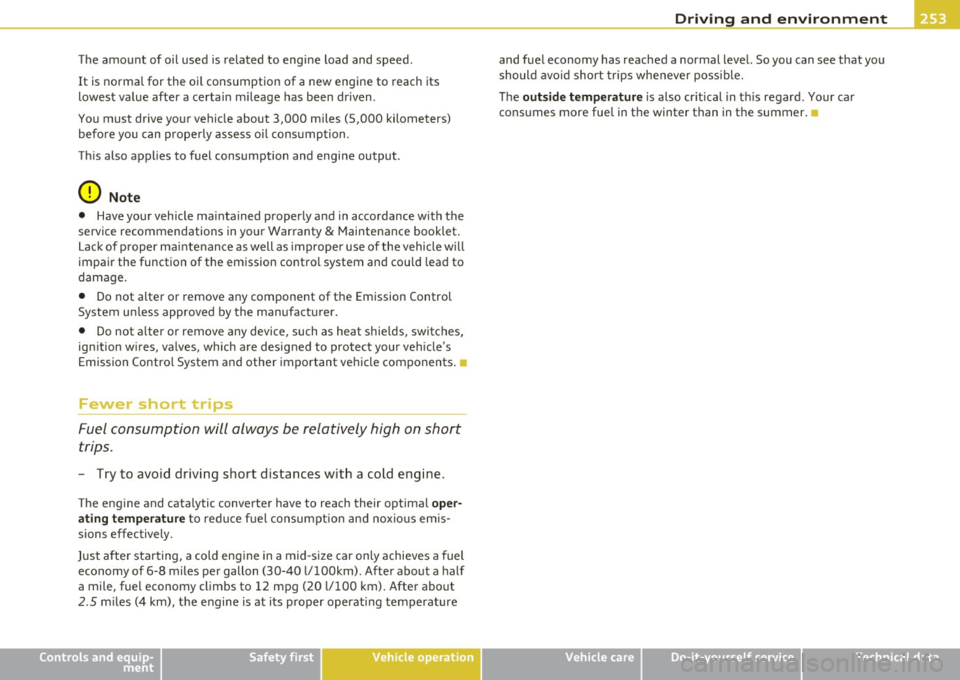
Driving and environment
------------------------------------------------'
The amount of oil used is related to engine load and speed.
It is normal for the oil consumption of a new engine to reach its
lowest value after a certain mileage has been driven .
You must drive your vehicle about 3,000 miles (5,000 kilometers)
before you can properly assess oil consumption.
This also applies to fuel consumption and engine output .
0 Note
• Have your vehicle maintained properly and in accordance with the
service recommendations in your Warranty
& Maintenance booklet.
Lack of proper maintenance as well as improper use of the vehicle w ill
impair the function of the emission control system and cou ld lead to
damage.
• Do not alter or remove any component of the Emission Control
System un less approved by the manufacturer.
• Do not a lter or remove any device, such as heat shie lds, switches,
ignition wires, valves, which are designed to protect your vehicle's Emission Contro l System and other important vehicle components. •
Fewer short trips
Fuel consumption will always be relatively high on short
trips .
-Try to avoid driving short distances with a cold engine.
The eng ine and catalytic converter have to reach thei r optima l oper
ating temperature
to reduce fuel consumption and noxio us em is
sions effectively.
Just after starting, a cold engine in a mid -size car only achieves a fuel
economy of 6-8 miles per gallon (30-40 l/l00km). After about a half
a mile, fuel economy climbs to 12 mpg (20 l/100 km). After about
2.5 miles (4 km), the engine is at its proper operating temperature
Controls and equip
ment Safety first Vehicle operation
and fuel economy has
reached a normal level. So you can see that you
should avoid short trips whenever possible.
The
outside temperature is also cr it ical in th is regard . Your car
consumes more fuel in the winter than in the summer. •
Vehicle care Do-it-yourself service Technical data